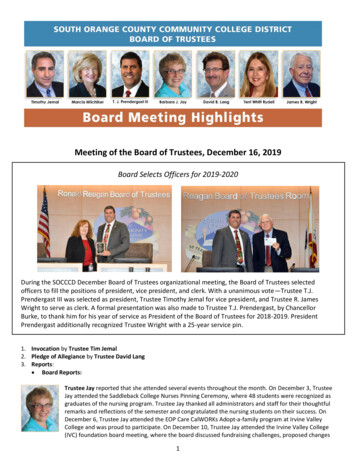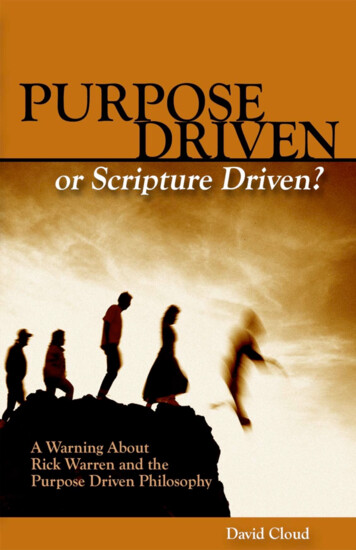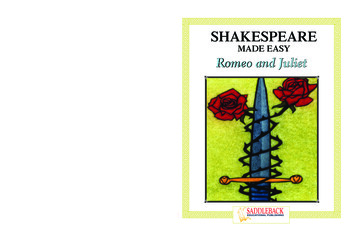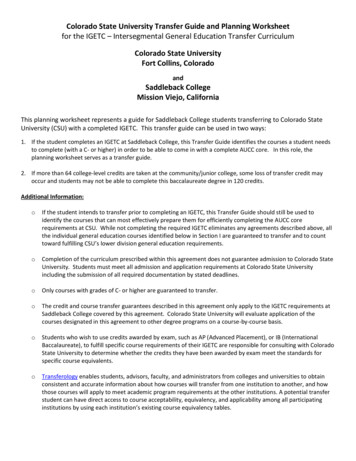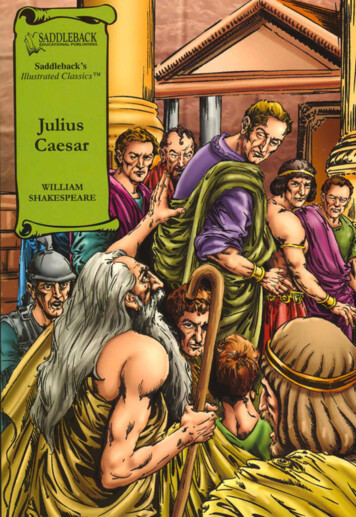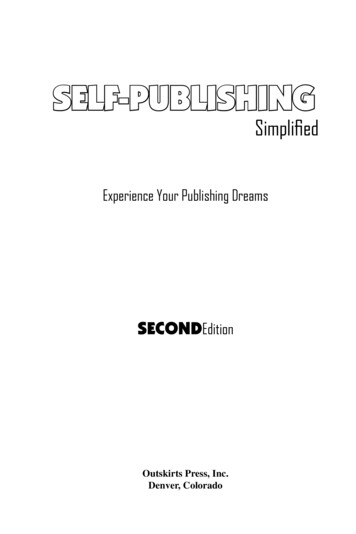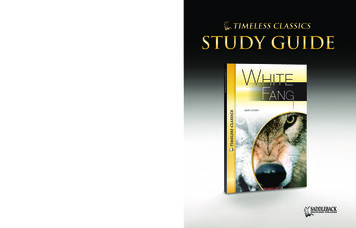
Transcription
Saddleback Educational PublishingSTUDY GUIDEThe Timeless Classics Study Guides provide awealth of reproducible support materials tohelp students extend the learning experience.on both the author and the times, characterdescriptions, chapter summaries, and eight“universal” exercises—focusing on plot, theme,character, vocabulary, important literary terms,and book report structure.ISBN-13: 978-1-61651-158-6ISBN-10: 1-61651-158-3S T U D Y G U I D E - w h ite f a n gFeatures include critical background notesSTUDY GUIDE
Contents Notes to the Teacher . . . . . . . . . . .4Facts About the Author . . . . . . . .5Facts About the Times . . . . . . . . .5Facts About the Characters . . . . . .6Chapter Summaries . . . . . . . . . . .7Answer Key . . . . . . . . . . . . . . . . .9Literary Glossary . . . . . . . . . . . .12CHAPTER r Study, Ch. 9 . . . .29Words and Meanings, Ch. 9 . . . 30Words and Meanings, Ch. 10 . . . 31Inference, Ch. 10 . . . . . . . .32Words and Meanings, Ch. 11 . . . 33Words and Meanings, Ch. 12 . . . 3422 Comprehension Check, Ch. 12 . . 3523 Words and Meanings, Ch. 13 . . 3624 Mystery Words, Ch. 13 . . . . 37Words and Meanings, Ch. 1 . . . 14Comprehension Check, Ch. 1 . . 15END-OF-BOOK EXERCISESWords and Meanings, Ch. 2 . . . 1625 Book Sequence . . . . . . . . . . 3826 Final Exam, Part 1 . . . . . . . 3926 Final Exam, Part 2 . . . . . . . 40Cause and Effect, Ch. 2 . . .17Words and Meanings, Ch. 3 . . . . 18Recalling Details, Ch. 3 . . .19Words and Meanings, Ch. 4 . . . 20Main Ideas, Ch. 4 . . . . . . . .21Words and Meanings, Ch. 5 . . . 22Comprehension Check, Ch. 5 . . 23Words and Meanings, Ch. 6 . . . 24Sequence of Events, Ch. 6 . . . 25Words and Meanings, Ch. 7 . . . 26Drawing Conclusions, Ch. 7 . . 27Words and Meanings, Ch. 8 . . . 28UNIVERSAL EXERCISES2728293031323333Beyond the Text . . . . . . . . .41Plot Study . . . . . . . . . . . . .42Theme Analysis . . . . . . . . .43Character Study . . . . . . . . .44Vocabulary Study . . . . . . . .45Glossary Study . . . . . . . . . .46Book Review, Part 1 . . . . . .47Book Review, Part 2 . . . . .48
TIMELESS ClassicsNOTES TO THE TEACHERTHE NOVELSTimeless Classics were expressly designed tohelp struggling readers gain access to some ofthe world’s greatest literature. While retainingthe essence and stylistic “flavor” of the original,each novel has been expertly adapted to areading level that never exceeds grade 4.0.An ideal introduction to later investigationsof the original works, Timeless Classicsutilize a number of strategies to ensure theinvolvement of struggling readers: airy,uncomplicated page design; shortenedsentences; easy-reading type style; eliminationof archaic words and spellings; shortened totalbook length; and handsome illustrations.To further engage struggling readers, someof our Timeless Classics titles are available in anew and exciting graphic format, which canbridge literacies and build complex readingskills—a perfect opportunity for differentiation.THE STUDY GUIDESThe Timeless Classics Study Guides providea wealth of reproducible support materials to helpstudents extend the learning experience. Featuresinclude critical background notes on both theauthor and the times, character descriptions,chapter summaries, and eight “universal”exercises that may be used for any TimelessClassic or Saddleback Illustrated Classic.In addition to the universal exercises, 26title-specific activities are included to review,test, or enrich the student’s grasp of importantvocabulary and concepts. These reproducibleworksheets are designed to be used chapter-bychapter as the student’s reading of the novelproceeds. At least two exercises are providedfor each book chapter. One of the two alwaysfocuses on key vocabulary. The other may bea simple comprehension check or present animportant literary concept.4Research shows that the most effective wayto improve comprehension is to teach studentsstrategies. The foundation of any comprehensionstrategy requires knowledge of the skills foundin these activities including: main idea, notingdetails, drawing conclusions, finding thesequence, cause and effect, making inferences,and more. A two-page final exam is also includedin every Timeless Classics Study Guide.USING THE STUDY GUIDESBefore assigning any of the reproducibleexercises, be sure your students each have apersonal copy of the Glossary and the FactsAbout the Author and About the Times. Byorganizing the reading process in this way, youwill be able to set a purpose for reading andactivate prior knowledge. The Facts About theAuthor and About the Times lend themselvesto any number of writing or research projectsyou may wish to assign. To further preview thenovel, you may wish to review the Facts Aboutthe Characters. Students will also need to befamiliar with many of the literary terms in orderto complete the worksheets.The title-specific exercises may be usedas a springboard for class discussions androle-playing. Alternatively, you may wish toassign some exercises as homework and othersduring the closing minutes of a class period.All exercises in this Guide are designed toaccommodate independent study as well asgroup work. The occasional assignment of studypartners or competitive teams often enhancesinterest and promotes creativity. Oral languageactivities, such as paraphrasing or summarizinga part of the story, provide an interventionopportunity to strengthen oral language skillsand, in turn, strengthen reading skills.
white fangFACTS ABOUT THE AUTHORJACK LONDON(1876–1916)EARLY LIFEBorn in 1876, Jack London was raisedin dire poverty in the slums of Oakland,California. As a boy of 10, he soldnewspapers on the streets before goingto school each day. While still a teenager,he worked as an oyster pirate, a cannerylaborer, and a salmon fisherman.PROFESSIONAL CAREERBefore he was 20, he joined the goldrush to Alaska. His stepsister loaned him 1,500 for his trip to the Klondike. Theonly “gold” he found there, however,was the rich and colorful material heused in his wonderful adventure stories.While still very young, Jack Londonwas making a name for himself as areporter for the Hearst newspaper chain.But, like all of his other jobs, this onedidn’t last long. Early in 1900, at theage of 24, he began his career as aserious writer.London’s literary interest includedscience fiction and serious novelsabout the plight of the underprivileged.Although he wrote for only 16 years, heproduced an impressive body of work:19 novels, 18 books of essays and shortstories, and numerous other books.OTHER WORKSHis most popular works, however, areThe Call of the Wild and White Fang,which have been translated into 30languages and are still popular all overthe world.LATER LIFETroubled all of his life by ill healthand financial problems, Jack Londondied at the age of 40 in 1916.FACTS ABOUT THE TIMESIn 1876, when Jack London was born.Alexander Graham Bell invented thetelephone, Mark Twain’s The Adventuresof Tom Sawyer had been out for ayear, and the first American zoo wasestablished in Philadelphia.In 1903, when White Fang waspublished.Work began on the Panama Canal,Orville and Wilbur Wright flew the firstpowered airplane, and the first car tripacross the United States was made in65 days.In 1916, when Jack London died.Jazz was sweeping the United States,the Battle of Verdun was fought inWorld War I, Pancho Villa invadedColumbus, New Mexico, and the firstRose Bowl football game was held.5
White FangFACTS ABOUT THE CHARACTERSBILL and HENRYLIP-LIPtwo weary men are trying to maketheir way across Alaska by dogsled. Asthey travel, their dogs are eaten, one byone, by a starving pack of wolves whoeventually eat the men as wella big sled-dog puppy who constantlytorments White Fang. He finallybecomes White Fang’s victim whenthey are both out in the wildKICHEthe Indian who takes Kiche fromGray Beaver as partial payment ofa debta part-dog “she-wolf” lures away Billand Henry’s sled dogs. She returns fromthe wild to Gray Beaver, an Indian, andis then passed on to a man named ThreeEagles. Along the way, the she-wolfgives birth to White FangONE EYEMIT-SAHGray Beaver’s son, he recognizesLip-Lip’s bullying ways and teacheshim a lessonBASEEKKiche’s mate and the father of WhiteFang, he is eventually killed and eatenby a lynxthe first sled dog that White Fangsuccessfully challengesWHITE FANGBEAUTY SMITHKiche’s gray cub, his first master isGray Beaver, followed by a cruel mannamed Beauty Smith, and finally byWeedon Scott. His many hardships inthe wild, followed by his adaptation tocivilization, form the central storylineof the booka harsh and brutal man who takesownership of White Fang by givingwhisky to Gray Beaver, he makes agood deal of money by betting on WhiteFang in dogfightsGRAY BEAVERan Indian who teaches White Fanghis first lessons about the ways of man.He eventually trades White Fang for asupply of whisky6THREE EAGLESTIM KEENANthe owner of Cherokee, a fightingbulldogWEEDON SCOTTa mining engineer, he forcibly buysWhite Fang from Beauty Smith andreturns to his family home in Californiawith the half-wild wolf-dog
MATTCOLLIEWeedon Scott’s assistant, he beginstaming White Fang by gently offeringhim meata sheepdog on the Scott estate, shebecomes White Fang’s mate and bears alitter of puppiesJUDGE SCOTTJIM HALLWeedon’s father, he is the owner ofSierra Vista, an estate in the Santa ClaraValleyan escaped convict sentenced to 50years in prison by Judge Scott, he is killedby White Fang when he comes to SierraVista, seeking revenge on the judgeWhite FangCHAPTER SUMMARIESCHAPTER 1Two hungry men named Bill andHenry are traveling the wilds of Alaskaon a dogsled. Game has been scarcefor days, and their dogs are graduallybeing picked off by starving wolves.Frightening howls surround them whenthey’re camping one night. They see ashe-wolf stealing food from their dogs.Bill becomes so angry and upset thatHenry determines to cheer him up thenext day.CHAPTER 2The next morning, the men have tounharness their dogs when the sledoverturns. The two men watch as a dogcalled One Ear runs after the she-wolf.Furious, Bill takes his rifle and runsinto the forest after them. Henry hearsa great commotion and sadly realizesthat both the man and the dog have beenfatally attacked by the wolves. Now hehas only two dogs to pull his sled thenext day. That night and the next night,Henry throws firebrands at the starvingwolves as they circle the campfire.Finally giving in to exhaustion, he stopsfighting, falls asleep, and allows thewolves to close in on him.CHAPTER 3The wolves bring down an 800-poundbull moose and end their fasting. Then,two by two, the males and femalesseparate from the pack and go off intothe woods. Of the four left, the threemales fight it out for the she-wolf. Sheand the winner, One Eye, go on together,sharing their food and adventures in thewild. One day the she-wolf leads theway to a cave and stays to bear five wolfpups. One Eye vies with a lynx for aporcupine and eventually brings his killback to the she-wolf.7
Timeless ClassicsLITERARY GLOSSARYaction what happens in a story; theacts or events that take placeThe war story was full of battle action.author the writer of a book, story, article, etc.Ernest Hemingway was an American author.author’s purpose the author’s specificgoal or reason for writing a certain bookIn that novel, the author’s purposewas to make readers laugh.character a fictional person who playsa part in a story or novelLong John Silver is an importantcharacter in Treasure Island.classic excellent artwork, novel,painting, symphony, etc. that remainspopular over many yearsNorman Mailer’s The Naked and the Deadhas become an American classicclimax the outcome of the novel’smain conflictThe capture of the criminal was theclimax of the detective story.conclusion the resolution of all plotconflicts, bringing the story to a closeThat play’s conclusion was verysatisfying. Every conflict was resolved.conflict The struggle between charactersor forces at the center of the storyThe conflict was resolved when thesuspect confessed.description the parts of a story or novelthat tell about the appearanceof the setting or charactersHis description of the Alps was breathtaking.dialogue words spoken by the charactersin a novel, story, or playThe dialogue in that comedy is verywitty and amusing.12effect in literature, an impressioncreated by the writerMurder mysteries often create asuspenseful, chilling effect.event a specific occurrence; somethingthat happensA plane crash is the first eventin that adventure novel.fiction a literary work in which theplot and characters are the productsof the author’s imaginationMary Shelley’s Frankenstein is apopular work of fiction.figurative language colorful wordingnot meant to be taken literally, but toform a colorful, sharp picture in themindA “screaming” headline may be set inlarge type, but it makes no sound at all.imagery figures of speech that helpthe reader to visualize the charactersor setting; pictures in wordsIn Stephen Crane’s imagery, thecolor of blood suggests courage.introduction a short reading thatpresents and explains a novel;sometimes the first part of a novelthat sets the sceneThe introduction to Frankenstein isin the form of a letter.mood the overall feeling or atmospherethe author creates in a story or novelThe author’s skillful use of languagecreated a dismal, hopeless mood.moral the instructive point of a storyor novel; the lesson to be drawn bythe readerThe moral of the story is to chooseyour friends carefully.
1White Fang Chapter 1WORDS AND MEANINGSnamedateA. Use the clues to complete the crossword puzzle. Answers are words from Chapter 1.ACROSS12. tubes that hold gunpowderand the bullet or shot usedin a firearm24. to chew away bit by bit43CG7. the act of repeatingsomething again and again8. the long wailing cry ofdogs, wolves, etc.DS5N6T7R8H99. something used as a lureto attract attentionDDOWN1. faint light; somewhat dark5. restless, tense feeling3. large, silver fish withorange-pink meat6. worked with great effortB. Use words from the puzzle to complete the sentences.1. A form disappeared across the snow.2. Henry asked Bill how many they had left.3. That day was a of all the days that had gone before.4. The two men without speech across the face of thefrozen world.5. One Ear could through leather as clean as a knife.6. The she-wolf was the for the pack.7. In the frozen Northland, meat was .8. The she-wolf snatched part of the dogs’ .14Saddleback Educational Publishing 2011 www.sdlback.com
2White Fang Chapter 1COMPREHENSION CHECKnamedateA. Circle a letter to complete the sentence or answer the question.1. The region called the Arctic is locateda. in southernb. around thec. around theAlaska. North Pole. South Pole.2. Bill and Henry were traveling on what kind of vehicle?a. snowmobileb. tobogganc. dogsled3. Instead of camping in the wild, Bill wished he wasa. in Florida.b. at Fort McGurry.c. home in bed.4. The strange thing about the she-wolf was hera. cinnamon color.b. savageness.c. red eyes.5. How did Henry signal Bill to turn around and look behind him?a. He waved.b. He called out.c. He whistled.6. Bill compared wolves to what kind of aquatic animals?a. whalesb. sharksc. polliwogsb. wolf-killers.c. M-16s.7. Bill called their riflesa. shootin’-irons.B. Look back through the chapter if you need information to answer the questions.1. Name three of the four dogs mentioned in the chapter.2. Why did Henry tell Bill to “shut up his wishing”?Saddleback Educational Publishing 2011 www.sdlback.com15
3White Fang Chapter 2WORDS AND MEANINGSnameA. Circle the hidden words. They maygo up, down, across, backward, ordiagonally. Check off each word asyou find CHPNOJPMLRGEOXZIMGSWERVEDEWPEFLSNARLSB. Write the puzzle word that matches each clue.1. :7. :bullets, bombs, rockets turned aside, changed direction2. :8. :grab, snatch animals, creatures3. :9. :huge, gigantic uncontrolled muscle clench4. :10. :paused, held back curved bones around the chest5. :11. :tired, weary, worn out dim light, partial darkness6. :12. :fierce growls becoming injured by heat16Saddleback Educational Publishing 2011 www.sdlback.com
of the book GRAY BEAVER an Indian who teaches White Fang his first lessons about the ways of man . He eventually trades White Fang for a supply of whisky LIP-LIP a big sled-dog puppy who constantly torments White Fang . He finally becomes White Fang's victim when they are both out in the wild THREE EAGLES the Indian who takes Kiche from
